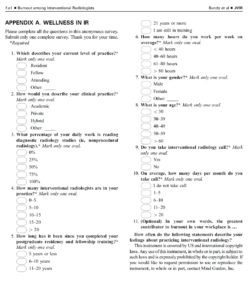
Burnout is prevalent among interventional radiologists, with a recent survey finding that both identifying as female and working more than 80 hours per week are significantly associated with high emotional exhaustion and depersonalisation (p=0.009 and p=0.030, respectively).
The survey results were published in the Journal of Vascular and Interventional Radiology by joint first authors Jacob Bundy (Department of Radiology, University of Michigan Health System, Ann Arbor, USA) and Anthony Hage (Department of Surgery, Thomas Jefferson University Hospital, Philadelphia, USA) et al.
Aiming to assess the prevalence of burnout and to determine demographic and practice-related stressors among interventional radiologists, Bundy, Hage and colleagues posted a 34-question survey to the Society of Interventional Radiology (SIR) Connect Open Forum website, which on the day of posting (7 January 2019) had 7,402 members. From the total membership, there were 339 complete responses. The prevalence of burnout was 71.9% (244 respondents).
This abundance of burnout places interventional radiologists in the upper range of that reported amongst all medical specialties. The prevalence of this condition in medicine as described in the literature varies from 30–75%. In fact, the authors write, “Interventional radiologists report manifestations of burnout at a rate higher than not only the general public (28%) but also diagnostic radiologists (54–61%) and surgeons (40%)”.
Bundy, Hage et al believe that the survey answers “indicate that additional harmful external factors exist and may require attention when combating burnout among interventional radiologists”. Highlighting perceived gender stereotypes, bureaucracy and administrative duties as prominent amongst these external factors, the authors say that these “represent problems that may not be resolved through established physician wellness programmes, but instead may require human system interventions driven by organisational restructuring and redirection toward patient-centred care rather than financial obligations”.
Interventional radiologists at high risk of emotional exhaustion and depersonalisation
The study authors define burnout as “a cluster of symptoms that occur in response to chronic emotional career-related stressors resulting in emotional exhaustion, depersonalisation, and lack of personal accomplishment in relation to one’s professional activity”. It was evaluated using the 22-item Maslach Burnout Inventory-Human Services Survey (MBI) for Medical Personnel (Mind Garden). Additionally, the survey included 10 demographic questions, ascertaining age, gender, current level of practice, time since fellowship training, practice setting, number of interventional radiologists in the practice, daily percentage of time spent performing nonprocedural diagnostic radiology, mean weekly hours worked, presence of interventional radiology (IR) call duties, and mean number of call shifts taken per month. An optional, open-ended, free response question regarding the greatest contributor to burnout in the workplace was also included.
A total of 61.9% of responders were at high risk of emotional exhaustion, according to the MBI subscales. A further 15.3% were at a moderate risk, and the remaining 22.7% were low risk. The mean MBI score for emotional exhaustion was 30±13, which is categorised as high (low ≤18; moderate 19–26; high ≥27). The mean depersonalisation score was also high, at 10.6±6.9 (low ≤5; moderate 6–9; high ≥ 10). Just over half of survey respondents—54.3%—were at high risk of depersonalisation. An additional 17.2% were at a moderate risk, and 28.6% were low risk. One-hundred-and-sixty-two (47.8%) responders were at high risk of both depersonalisation and emotional exhaustion.
“Personal achievement scores were high in only 14.7%” of respondents, the authors write. Personal achievement ranking was not used to determine if a participant had burnout. Most responders (59.3%) reported low personal achievement, and 26% reported a moderate personal achievement rating. However, the mean personal achievement rating was 39.6±6.6, just shy of a “high” designation (low ≥40, moderate 34–39, high ≤ 33).
Explaining the open-ended responses received, which were given by 258 survey participants (76.1%), the authors say: “On review of the responses, several themes emerged, including administrative pressures on productivity and administrative tasks, relationships between interventional radiologists and ancillary staff, workload and work hours, electronic medical record and documentations systems, diagnostic radiology responsibilities, contentious relationships with diagnostic radiologists within the same practice, lack of recognition and respect from other medical and surgical subspecialties, and fielding inappropriate consultations from other medical professionals”.
Bundy, Hage et al express concern at their finding, continuing: “The technical challenges, physical demands, and unpredictable work hours of IR likely impart different stressors [to those experienced by other medical specialties, such as diagnostic radiology], and thus rates of burnout may be related to these factors. Regardless, this is an alarming finding given the negative impact burnout has on job satisfaction, career longevity, mental health, and patient care”.
Female interventional radiologists are more likely to experience burnout than male physicians
Gender was significantly associated with increased rates of burnout, with women having 2.4 times’ higher odds of experiencing burnout than men. (See here for a first hand testimonial of burnout). The study authors say that “Gender judgement and stereotypic perceptions of female physicians have been linked to increased rates of burnout and worsened psychological well-being”. To remedy this, Bundy, Hage and colleagues suggest that increasing the number of women in the male-dominated discipline of interventional radiology “may mitigate the relationship between stereotypic perceptions and burnout among women”.
That women have an increased propensity to work more than 80 hours a week compared with their male counterparts is also potentially a contributing factor to their higher incidence of burnout, according to the study investigators. Interventional radiologists who worked more than 80 hours per week were seven times more likely to report traits indicative of burnout than those who worked fewer than 80 hours in a week.
“Of note”, the authors write, “the form of call taken in the present survey was not assessed; however, IR call shifts would likely contribute differently than diagnostic radiology call shifts toward the total hours worked”. They continue, “Whereas physician expectations for acceptable work hours vary by specialty, a dependent response is likely present between work hours and burnout. Although not an easily applicable intervention, decreasing work hours or other contributors to overall workload may have a substantial impact on lowering the incidence of burnout amongst interventional radiologists”.
The authors also note that, despite the fact that the survey was intended to capture a representative cross section of interventional radiologists in training and practice, respondents were disproportionately early career physicians. They suggest additional analyses of burnout within age-specific subsets of IR physicians and trainees to “further delineate the aetiologies of burnout among these groups”.














339/7200 response rate
70% burnout in that group
Could there be selection bias